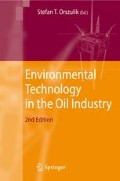A typical oil refinery operates continuously, manufacturing a wide range of products for a variety of end uses. The products pass from the processing units to refinery tankage but, as storage capacity at refineries is finite, their early transfer into the distribution network is essential for operation to continue at or near the designed throughput.
Refineries have the capability to manufacture many different types of material: gases, solvents, jet and burning kerosine, cracker and petrochemical feedstocks, gasoline, diesel fuel, domestic heating oil, residual fuel, lubricants, waxes and bitumen. Applications in which these products are used vary widely but a very high proportion of refinery output is burned as fuel.
Access this chapter
Tax calculation will be finalised at checkout
Purchases are for personal use only
Preview
Unable to display preview. Download preview PDF.
References
CONCAWE (1986) Sulphur emissions from combustion of residual fuel oil based on EEC energy demand and supply, 1980–2000. CONCAWE Report No. 5/86.
CONCAWE (1988) Capital and operating cost estimating aspects of environmental control technology–residue hydrodesulphurization as a case example. CONCAWE Report No. 88/51.
CONCAWE (1988) The control of vehicle evaporative and refuelling emissions–the ‘on-board’ system. CONCAWE Report No. 88/62.
CONCAWE (1990) European soil and groundwater legislation: implications for the oil refining industry. CONCAWE Report No. 4/90.
CONCAWE (1992) The environmental benefits and cost of reducing sulphur in gas oils. CONCAWE Report No. 3/92.
CONCAWE (1992) VOC emissions from the loading of gasoline into ships and barges in EC 12: control technology and cost-effectiveness. CONCAWE Report No. 92/52.
CONCAWE (1992) CONCAWE Product Dossier No. 92/103: Gasolines.
CONCAWE (1992) CONCAWE Review, 1(2), October.
CONCAWE (1993) The European environmental and refining implications of reducing the sulphur content of marine bunker fuels CONCAWE Report No. 1/93.
CONCAWE (1993) CONCAWE Review, 2(2), October.
CONCAWE (1994) The contribution of sulphur dioxide emissions from ships to coastal deposition and air quality in the channel and southern north sea area. CONCAWE Report No. 2/94.
CONCAWE (1994) Trends in oil discharged with aqueous effluents from oil refineries in western Europe–1993 survey. CONCAWE Report No. 3/94.
CONCAWE (1994) Motor vehicle emission regulations and fuel specifications: 1994 update. CONCAWE Report No. 4/94.
CONCAWE (1994) The performance of oil industry cross-country pipelines in western Europe. CONCAWE Report No. 5/94.
CONCAWE (1994) CONCAWE Review, 3(2), October.
CONCAWE (1995) CONCAWE Review, 4(1). April.
Department of the Environment (1993) Diesel Vehicle Emissions and Urban Air Quality, Second Report of the Quality of Urban Air Review Group, H.M. Stationery Office, London, December.
Owen, K. and Colcy, T. (1995) Automotive Fuels Reference Book, 2nd edn, Society of Automotive Engineers, Warrendale, PA.
CONCAWE (1995) Interim report on the European refining implications of severe reformulation of gasoline and diesel fuel. CONCAWE Report No. 95/54.
CONCAWE (1997) Motor vehicle emission regulations and fuel specifications–Part 2 Detailed information and historic review (1970–1996). CONCAWE Report No. 6/97.
CONCAWE (1999) Fuel quality, vehicle technology and their interactions. CONCAWE Report No. 99/55.
CONCAWE (1999) Potential of exhaust after treatment and engine technologies to meet future emissions limits. CONCAWE Report No. 99/62.
CONCAWE (1999) Best available techniques to reduce emissions from refineries. CONCAWE Report No. 99/01.
CONCAWE (2000) Impact of a 10 ppm sulphur specification for transport fuels on the EU refining industry. CONCAWE Report No. 00/54.
CONCAWE (2001) Motor vehicle emission regulations and fuel specifications: Part 2 Detailed information and historic review (1996–2000). CONCAWE Report No. 2/01.
CONCAWE (2002) Sulphur dioxide emissions from oil refineries and combustion of oil products in western europe and hungary (1998). CONCAWE Report No. 10/02.
CONCAWE (2002) VOC emissions from loading gasoline onto sea-going tankers in EU-15: control technology and cost effectiveness. CONCAWE Report No.6/02.
CONCAWE (2002) Evaluation of diesel fuel cetane and aromatic effects on emissions from euro-3 engines. CONCAWE Report No. 4/02.
CONCAWE (2002) Western European pipelines. 30 years of spillage performance monitoring. CONCAWE Review, 11(1), April.
CONCAWE (2003) Fuel effects on emissions from modern gasoline vehicles: Part 1 Sulphur effects. CONCAWE Report No.5/03.
CONCAWE (2003) Fuel quality and emissions–rising to the challenges of increasingly demanding fuel specifications. CONCAWE Review, 12(2), October.
CONCAWE (2004) Motor vehicle emission regulations and fuel specifications: Part 1 2002/2003 update. CONCAWE Report No. 9/04.
CONCAWE (2004) Trends in oil discharged with aqueous effluents from oil refineries in Europe 2000 survey. CONCAWE Report No. 4/04.
CONCAWE (2004) The City Delta Project–assessing urban air pollutant effects. CONCAWE Review, 13(1), April.
CONCAWE (2004) Advanced vehicles and fuels–some recent emissions results. CONCAWE Review, 13(1), April.
CONCAWE (2004) Joint European Well to Wheels study–an analysis of future automotive fuels and powertrains in the European context. CONCAWE Review, 13(1), April.
CONCAWE (2005) Fuel effects on emissions from advanced diesel engines and vehicles. CONCAWE Report No. 2/05.
CONCAWE (2005) Performance of European cross-country oil pipelines. Statistical summary of reported spillages–2003. CONCAWE Report No. 3/05.
CONCAWE (2005) A European framework for waste quality. Key features and potential impacts on the downstream oil industry. CONCAWE Review, 14(1), Spring.
CONCAWE (2005) ERTRAC–A unique opportunity to improve the effectiveness of research on road transport in Europe. CONCAWE Review, 14(1), Spring.
Author information
Authors and Affiliations
Editor information
Editors and Affiliations
Rights and permissions
Copyright information
© 2008 Springer Science + Business Media B.V
About this chapter
Cite this chapter
Coley, T., Price, J. (2008). Distribution, Marketing and Use of Petroleum Fuels. In: Orszulik, S.T. (eds) Environmental Technology in the Oil Industry. Springer, Dordrecht. https://doi.org/10.1007/978-1-4020-5472-3_11
Download citation
DOI: https://doi.org/10.1007/978-1-4020-5472-3_11
Publisher Name: Springer, Dordrecht
Print ISBN: 978-1-4020-5471-6
Online ISBN: 978-1-4020-5472-3
eBook Packages: Chemistry and Materials ScienceChemistry and Material Science (R0)

